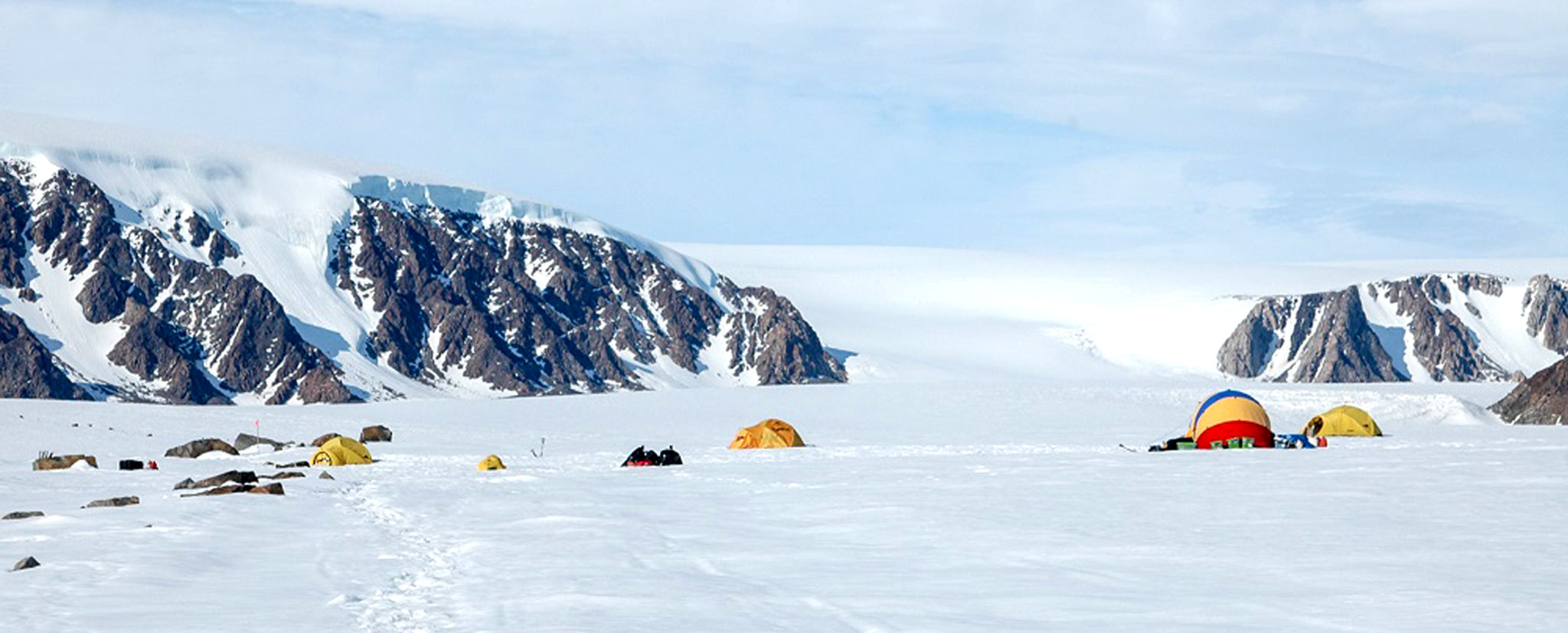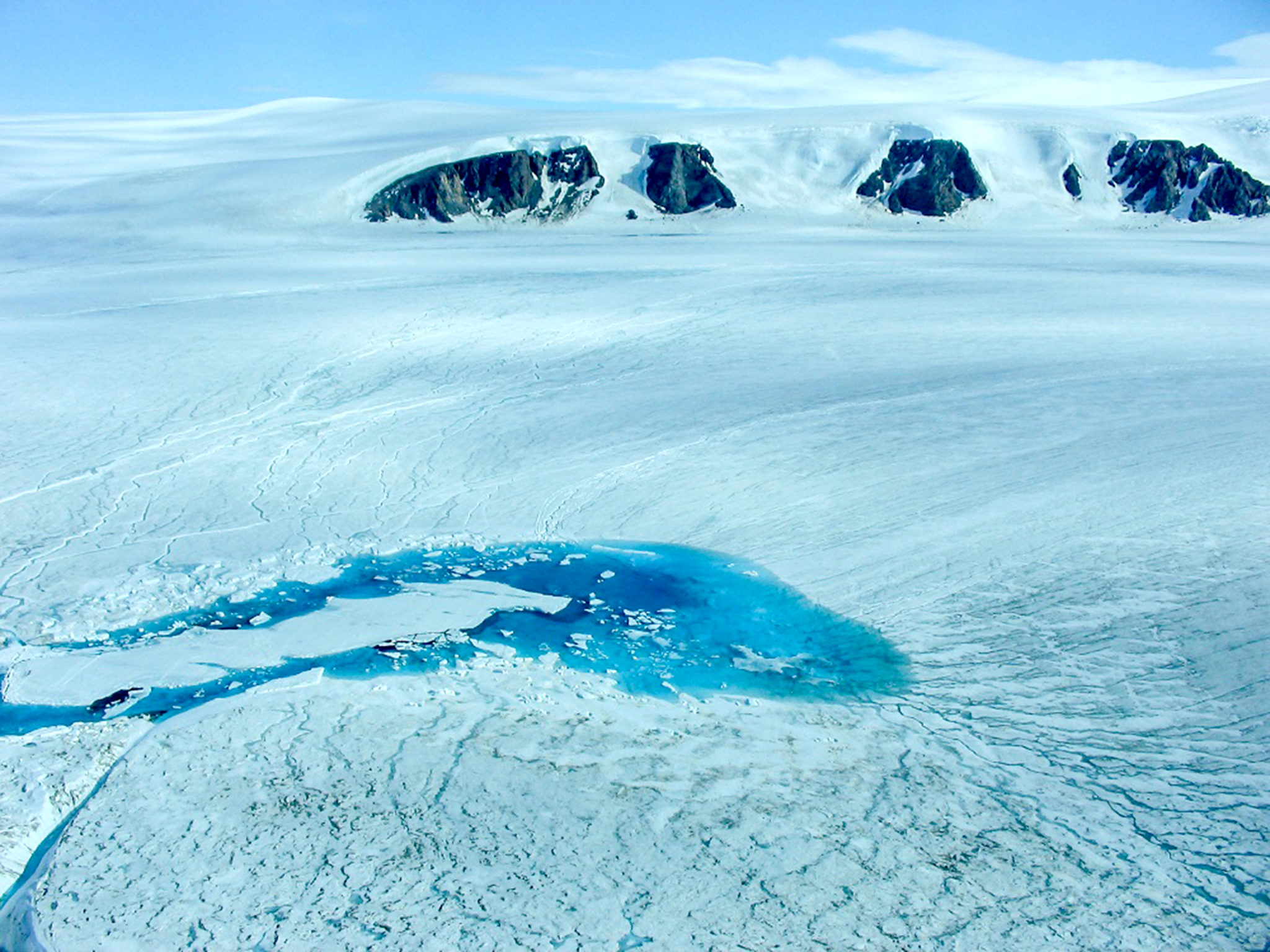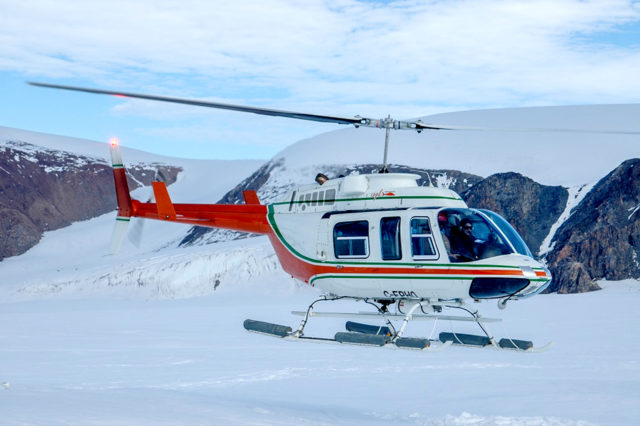
It was 10 p.m. one night in June of 2008 and we were cut off from our on-glacier camp. When we’d left that morning, it was sunny and the glacier surface was crisp and crunchy, perfect for our plastic boots and crampons. My graduate student and I had decked ourselves out in hats and sunscreen to protect us from the sun’s reflection off the ice, then headed up-glacier to check on a weather station and a stream gauge to make sure we were ready to capture all of the data we needed once spring melt began.
It was a long day, and by the time we headed back down-glacier, toward our camp, my bad knee had started acting up and I couldn’t walk without pain. To make the situation worse, we realized that things had changed while we were away from camp. The warm day had melted the snow on the lower glacier, leaving a shifting landscape of ice slurries in hidden surface channels surrounded by small hummocks of solid ice. We got within 1,500 feet of our camp and couldn’t go any farther, as there were two slushy streams between it and us that were just too wide and deep to cross. My graduate student tried to cross anyway, but the slush was like quicksand. I had to yell at him to lie down and pull himself out by the arms instead of trying to kick out with his legs. Now he was curled up in the tinfoil blanket from the emergency kit, icy wet to the waist and moaning about not wanting to die. Thank goodness for 24-hour daylight.
I couldn’t reach him, and neither of us could reach our camp. It was time to get out the satellite phone and call base camp in Resolute Bay, 250 miles southwest.
* * *
Not all Arctic researchers have had the luxury of satellite phones or shortwave radios. Take the English explorers at the turn of the century: If they got in trouble on their travels, they had only themselves to rely on. Searchers were only sent out if the expedition didn’t return after several years. This is what happened to Captain Sir John Franklin, who set off to traverse the last unexplored section of the Northwest Passage in 1845. The story ends badly — Franklin and his crew died of zinc deficiency and scurvy, some resorted to cannibalism, and they left artifacts strewn across the Arctic tundra as they tried to walk for help. Franklin’s wife pushed for a search for the missing expedition as early as 1848, but it was too late for Franklin and his crew. More than 50 expeditions searched for 12 years before concluding that every one of the 129 men was gone. The searchers found only graves, relics and Inuit stories about the expedition. It wasn’t until 2014 that Parks Canada and the Royal Canadian Geographical Society finally found one of Franklin’s abandoned boats, the H.M.S. Erebus, on the seabed where the Inuit had always said it was. The wreck of the H.M.S. Terror, Franklin’s second boat, was found in 2016 by the Arctic Research Foundation. Both sites are currently being explored in collaboration with the local Inuit.

Meltwater ponding on the glacier surface. All photos courtesy of the author.
The Arctic has long tempted researchers to take risks to answer questions of science. Consider Norwegian Fridtjof Nansen, who suspected that, rather than being static, sea ice was a dynamic system that moved ice from east to west across the Arctic Ocean, from Siberia to Greenland, and potentially over the North Pole itself.
To test his theory, in 1893 he sailed a custom-built, reinforced boat — the Fram — into the pack ice on Russia’s Laptev Sea, allowing it to freeze there and drift westward with the sea ice. Nansen took a huge risk with this experiment: The sea ice could have crushed his ship’s hull, or it could have drifted in an alternate direction, which would have left the crew without the food required to return home.
On the same trip, Nansen decided to make a run for the North Pole. In March of 1895, he raced north from the Fram with his companion, Fredrik Hjalmar Johansen, traveling by dogsled and carrying kayaks for open water travel. However, they were still 300 miles from the North Pole when they realized they had to turn back because they didn’t have enough food. Their plans called not for catching up with the Fram, but for reaching the archipelago of Svalbard, where they hoped to find a willing sea captain to take them home. They made it as far as Russia’s Franz Josef Land, in June of 1896, where they stopped to fix their kayaks after a walrus attack and then unexpectedly (and fortuitously) connected with explorer Frederick Jackson, who was leading an expedition there. They returned to Norway with Jackson, while the Fram itself was sighted west of Svalbard, exactly where Nansen had expected it to be as it drifted on the ocean currents. Unlike the Franklin expedition, everyone returned home alive — after being on the ocean and in each other’s sole company for three years.
More than a century later, our 2008 Arctic field program was part of a worldwide scientific endeavor called the Fourth International Polar Year (IPY), which focused on studies of the polar regions. Previous Polar Years had occurred from 1882 to 1883, 1932 to 1933, and 1957 to 1958 (this one was also called the International Geophysical Year, or IGY); all had resulted in new and interesting findings about Arctic processes, like sea ice and glaciers. For IPY #4, we were part of a global team, each subset of which was studying a specific glacier. Ours was the Belcher Glacier, which originated on the Devon Island Ice Cap in Arctic Canada.
In summer, our team on the lower part of the glacier and another team on the upper reaches of the glacier measured snow and surface water to determine how water on the surface was generated; we also observed how that surface water entered the glacier. The team at the terminus examined how the water affected the glacier’s forward motion. The main goal was to use our field data to develop and run a model of the glacier itself to see how it would respond to climate change, and to compare our results with those of the other international research teams. This was important for examining how fast polar ice sheets are declining and what that means for the future.

Glacier ice tumbling down a cliff and creating a mass of crevasses.
I had a bad feeling about the project from the beginning. Glacier travel can be done in pairs, but if someone falls into a crevasse — a deep crack that forms in the ice when the glacier flows over subglacial obstacles — you have to work pretty hard when you’re the only person there to save them. I wasn’t confident in my student’s ability to save me from a crevasse, and I hadn’t taken a refresher course in crevasse rescue myself to brush up on my own skills. A recurring knee injury that had been my bane during my three Arctic field seasons had also been acting up again just before this trip began. I was leery of camping on the ice in summer, as I was concerned about the amount of water generated on the glacier surface during spring and summer melt.
Turns out I was right about the problems with water, given our stranded situation. The upper glacier team experienced the same thing later in the season, but the slush formed while they were still in camp, so they just stayed put until it disappeared and crossable surface channels appeared. For my field partner and me, it was already too late to avoid the sudden ice streams — once he had been submerged, the only option was to evacuate as quickly as possible.
* * *
Standing on the ice, cut off from camp, with a grad student in terrible mental shape, I made the tough decision to call the base via satellite phone. Choking back a feeling of failure, I pressed the numbers that would connect me to base camp. After I explained our situation, they scrambled to find a chopper pilot who had enough hours left to fly, as most had exhausted their hours during the day and needed to sleep before they were permitted to fly again. Once they found a pilot, they had to ensure he was willing to fly 250 miles each way to rescue us.
Having gotten over my sense of failure, I fell into my default emergency mode, which I’d learned during Bronze Cross lifesaving training, where you have to rescue “victims” from the water and do first aid while talking to them and keeping them calm. I felt collected and in control as I talked to base to organize our rescue, pacing around on my small patch of ice, occasionally sitting down on my pack, talking to my grad student, and trying to stay positive and keep my mind off the long-term ramifications of this event. We would no longer be able to collect data from the lower part of the glacier, which would leave a data gap when the modeling team tried to represent the glacier numerically.

Meltwater ponding on the glacier surface. The helicopter chariot that flew us from base camp to our field site 250 miles away.
After several calls back and forth, during which the base requested information on weather (clear and calm), landing conditions (iffy), and the status of both myself (fine except for my knee) and my student (slowly losing it on the other side of the slushflow), they found a pilot willing and able to make the flight. He arrived early in the morning hours, when the sun was just burnishing the cliffs with a liquid golden hue. I have never been so glad to hear a chopper in the distance.
When he set down to pick up my student, the pilot almost got the chopper skids caught in the slush, which scared him a bit. Luckily the ice was firmer on my side, so I was easier to pick up. We flew the short distance to our camp — two small personal tents and a multicolored communal tent that looked like a slinky. We hurried to collect our essential personal effects, then boarded the chopper to head back to the base.
We arrived at the base in Resolute Bay around 5 a.m. — it was the only time I’d seen it so quiet. The dormitory hallways were empty, and the morning crew was just starting to make breakfast in the communal kitchen. The local nurse checked us over and, since I’d injured my knee again, I was given anti-inflammatories and an ice pack to keep the swelling down. My grad student was given something to calm down, but luckily he had no signs of hypothermia thanks to that foil blanket from the first aid kit. I went down to the base control room and thanked them for all they’d done — they were kind and considerate and thanked me for staying calm and helping them set up the rescue.
Then I limped back to my room and wondered how I was going to explain this event to the principal investigator on this research project, who had also been my Ph.D. supervisor. His response was surprisingly calm and measured; I felt I had disappointed him and let down the project team as a whole, but he took it all in stride.
If we’d had our incident in Nansen’s time, there would have been no home base to contact for help. We would have had to find our own way across the slushflows and to our camp, or we might have had to sit on the ice for a few days, waiting for the slush to disappear and leave surface channels behind. But would that have been so bad? We would have been hungry, but the 24-hour-daylight and good weather would have kept us from getting too cold. Did our situation warrant calling for a rescue? Was the fault ours for not having an extra tent with us, or some extra food? We had the essentials: the satellite phone, the first aid kit, and a shotgun in case we met a polar bear. And the base managers agreed there was little we could have done differently, which validated my decision somewhat. But I still wondered what would have happened if we had waited it out.

Roped up for safety as we travel around the glacier surface.
But among the researchers I know, we don’t wait. When there’s a problem, we call for help. With hindsight, it’s easy to think that we could have sat there for a few days and then been able to get back to camp. At the time, however, we had no idea how long it would remain slushy. Most importantly, however, my grad student was not in the best frame of mind to stay out on the ice and wait for the slush to disappear. There was no way I could have put him through that. And given my injured knee, how much work could we have done once the slushflows subsided, since I could hardly walk as it was?
Sometimes, even hindsight isn’t 20-20, and there are still questions that niggle at the back of your mind long after the emergency is over. What could I have done differently? What would have happened if I’d done A instead of B? It’s easy to get caught up in could-have-beens instead of focusing on what actually happened.
What would Nansen have done? He was a strong outdoor explorer who was comfortable running a dogsled team and kayaking in cold environments, and he was used to Norwegian cold-weather gear, which was more practical than Franklin’s team’s British woolen suits. He was confident in his ability to design and lead expeditions. As Pierre Berton writes in The Arctic Grail, “Nansen was daring but never rash; bold but never impulsive; fatalistic but never foolhardy; poetic but never naïve.”
He was also good at making new plans on the fly. He left his ship to head for the North Pole on the assumption that they could make it, but that didn’t work out due to food shortages, so he had to make a different plan. They headed south, depending partially on their watches for navigation. When he forgot to wind up the watches one morning, making it harder to determine how close they were to Franz Josef Land, he had to improvise based on a guess of where they might be.
Perhaps that’s the mark of the true explorer: someone who is able to make new, viable plans on the fly when things don’t go according to the original one. Someone who can think of several different outcomes at once and how to achieve them based on what they have on hand, right there and then. Someone who can sit out on the ice for a few days until the slushflows disappear.
But we were not explorers. We were scientists, with work to do and data to collect. We couldn’t do our work if we couldn’t reach our camp. Perhaps that’s the difference between what we did versus what Nansen would do.
* * *
Over the next few days, I worked with the base managers to organize a trip back to the glacier to clean up our camp. I went with the same chopper pilot who had rescued us, but my student wouldn’t come — he said he’d never step foot on a glacier again. I felt terrible that his enjoyment of glacier fieldwork had been so damaged by this episode, and I knew I couldn’t fix it.
Once we arrived at our camp, I felt the full weight of our failed field season as we packed a sling full of gear and flew it up to the upper glacier camp. Then I packed all of our personal gear into the backseat of the chopper and we traveled the three hours back to base. As we flew over the glacier, we could see surface streams forming where the slush had collected only a few days before. They were flowing with water instead of slush, and it was easy to see their boundaries. If we had stayed on the ice for a few days, we could perhaps have crossed the streams to our camp and kept on working as though nothing had happened. But the field season was over. We wouldn’t be coming back again.
I never went to the Arctic again after that trip. I didn’t have the budget to ship gear and people up north, and I also didn’t want to plan logistics for such a remote field site anymore. I was not like Nansen, who persevered on his journeys. I tried to remember my Arctic research fondly, but the Belcher Glacier episode was a dark spot on my conscience.
Our research was finally published nine years later, and it showed that meltwater from the glacier surface had definitely made the glacier flow faster. In all those years I never dreamed of the Arctic again, though I know my adventures played a small part in the long history of researchers attempting to understand the ice there.
Sarah Boon (Ph.D., FRCGS) has bylines at Longreads, Catapult, The Rumpus, Brevity, Outside Online, Alpinist Magazine, The LA Review of Books, Earth Island Journal, Literary Hub, Terrain.org, Hakai Magazine and more. She is a co-founder and serves on the Board of Science Borealis, Canada’s science blog aggregator. She is writing a book about her field research adventures.